The Divine Office, Edward J. Quigley [best book reader .txt] 📗
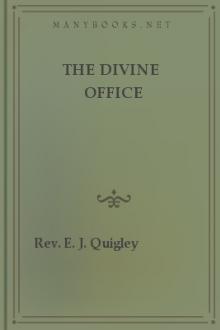
- Author: Edward J. Quigley
- Performer: -
Book online «The Divine Office, Edward J. Quigley [best book reader .txt] 📗». Author Edward J. Quigley
Benedicamus is the prayer to thank God for all His graces.
Fidelium animae. This prayer is said after every Hour, unless where the hour is said in choir and followed immediately by Mass. It Is omitted, too, before the Litany.
De Precibus (Title XXXIV.). These are prayers which are said at some of canonical Hours, before the collect or oratio. They commence with Kyrie eleison or Pater Noster. They consist of versicles and responses and these differ from other versicles and responses, which are generally historic, e.g., In omnem terram exivit sonus eorum, Amavit eum Dominus et laudavit eum. But the versicles and responses of the preces are always a call to God or an exhortation to praise God (e.g., Fiat misericordia tua, Domine), super nos, Quemadmodum speravimus in te (see Prime, infra, page 193). These prayers are of great antiquity, mention of them being found in the works of Amalare (ninth century).
They are said in some Offices in Vespers, Compline, Lauds, Prime and Little Hours. Before the reform of the Breviary by Pope Pius X,, the Preces at Vespers contained six short prayers and the Psalm, Miserere. In the new Breviary nine short prayers are given in the Preces—the six former prayers being retained and three new ones, Pro Papa; Pro antistite; Pro benefactoribus, being added. The Miserere is omitted. The same additions were made in Lauds and the Psalm, De Profundis omitted.
In Prime and the Little Hours, the preces are unchanged standing in the new Breviary as in the old.
Rubrics. The Preces are recited in the Office of—
(1) Prime and Compline on certain days;
(2) Lauds, Prime, Terce, Sext, None, Vespers and Compline of certain feasts.
The preces feriales at Lauds and Vespers are the same in structure. They have the same structure in Terce, Sext, None, but differ in character. The preces dominicales at Prime and Compline have a form of their own, additions being made in the preces of Prime when said on a feria.
1. The Preces Feriales are said at Lauds on Ferias of Lent, Advent and Passiontide, Ember days, except Ember day at Pentecost and on Vigils (except on Vigil of Christmas, Epiphany, Ascension, Friday after Ascension and Vigil of Pentecost)—when the Office on those days is of the current feria.
2. At Prime (i) Preces Dominicales are said in all semi-doubles, simples, Ferial Offices.
(i) They are said at Little Hours if said at Lauds.
(ii) At Prime, Preces Feriales are said if they have been said at Lauds.
3. At Vespers Preces Feriales are said (1) on ferias of Advent and Lent when office is of feria.
4. At Compline, Preces Dominicales are said on all (i) semi-doubles, (ii) simples, (iii) all Ferias, unless at Vespers a double or an octave was celebrated.
SOME TEXTS AND INTENTIONS WHICH MAY HELP TOWARDS THE DEVOUT RECITATION OF LAUDS.1. "And very early in the morning, the first day of the week, they come to the sepulchre, the sun being now risen."
They said to one another, "Who shall roll us back the stone from the door of the sepulchre?" (St. Mark, xv.).
2. "And looking, they saw the stone rolled back…. And entering the sepulchre they saw a young man sitting on the right side, clothed with a white robe; and they were astonished. Who sayeth to them, Be not affrighted; you seek Jesus of Nazareth Who was crucified. He is risen, He is not here" (St. Mark, xv.).
3. "Behold Jesus sayeth to her (Magdalen) 'Woman, why weepest thou?'"
4. "Behold Jesus met them (the women) saying to them 'All hail.'"
(5) "See my hands and feet, that it is I myself, handle and see" (St. Luke, xxiv.).
6. "Bring hither thy hand and put it into My side and be not faithless."
7. "My Lord and my God" (St, John, xx.).
General Intentions. The wants of the Church, peace among nations—vocations to the priesthood—Church students—souls in Purgatory.
Personal Intentions. A glorious resurrection; fervour in saying the Office; fervour in saying Mass; fervour in priestly work; forgiveness of all sin.
Special Intentions. For Catholic Ireland; for the conversion of America; for peace throughout the world.
PRIME (TITLE XV.).Etymology. The name Prime is derived from the Latin prima because this part of the Office was said at the first hour of the day, 6 a.m., with us, following the old Roman distribution of the day.
Origin. It was stated by some writers that this Hour was established by St. Clement and should therefore date from almost apostolic times. But modern writers, following the statement of Cassian, date the origin of this Hour from about the year 382. It was believed, too, that the monastery indicated by Cassian as the cradle of Prime was the monastery of Bethlehem, St. Jerome's monastery. But it was probably established not there, but in a monastery in the neighbourhood, Dair-er-Raociat (convent of the shepherds) or in Seiar-en-Ganheim (enclosure of the sheep). Cassian tells us the reason that led to the introduction of this Hour. Lauds ended at dawn, and the monks retired to rest. As no other choir work called them until Terce, at 9 a.m., some of them were inclined to rest until that hour and to neglect the spiritual reading and manual work laid down by their rule. To prevent this prolonged rest, it was decided to introduce a short choir service, the recital of a few psalms, and then the monks went to work until Terce (Cath. Encyclopedia, "Prime").
Contents. Originally the matter for Prime was drawn from Lauds and was a repetition of part of Lauds. Prime consists of two parts. The first part consists of hymn, psalms, little chapter and collect. The prayers and confiteor inserted before the collect and said on certain days are adjuncts. The second part contains the Martyrology (when Prime is said in choir) and other prayers peculiar to the Hour. "The reason for this divergence may be traced to the fact that Prime is of monastic institution and the second portion, which is said in the chapter house, has reference to monastic customs. The Martyrology and Necrology having been read, prayers were said for the dead recommended to the Community, as benefactors, friends, patrons, protectors, etc. Then followed a special prayer in preparation for manual labour of the day, and a chapter of the rule was read, on which the Abbot briefly commented or else gave some admonition to the Community. This monastic character will be easily recognised by a glance at the formulas used. The prayer, 'Sancta Maria et omnes sancti' forms a natural conclusion, to the reading of the Martyrology, The 'Deus in adjutorium,' the 'Pater Noster' with accompanying versicles, and the collect, are the prayers before manual labour: 'Respice,' etc., Look, O Lord, upon Thy servants and upon Thy works… and direct Thou the work of our hands. 'Dirige et sanctificare,' etc., 'Vouchsafe to direct and sanctify our senses, words and actions,' etc. Whilst the 'Dominus nos benedicat' and the 'Fidelium animae' are the conclusion of the prayers for the dead" (Dom Cabrol, Introduction to the Day Hours of the Church).
Structure:-i. Pater, Ave, Credo, silently. 2. Deus in adjutorium. … Domine ad adjuvandum .. with sign of the cross, Gloria Patri. … Sicut erat. … 3. Hymn, fam lucis. 4. Antiphon, first words only. 5. Psalms for the Sunday or feria as rubrics direct, with the Athanasian Creed if it be ordered, then the antiphon in full. 6. Regi saeculorum … or, Pacem et veritatem. … Deo Gratias, Christie, Fili Dei vivi…. 7. Preces, if they are ordered in the Office of the Day, Preces Dominicales or Preces feriales as rubrics direct. These include versicles, responses, confiteor, misereatur… indulgentiam… versicles responses. 8. Dominus vobiscum. Et cum spiritu tuo. Oremus, Domine Deus….. Amen. Dominus vobiscum, Et cum spiritu tuo. 9. Benedicamus Domino, Deo Gratias. 10. In choir, the martyrology is here read, 11. Pretiosa… mors…. 12. Sancta Maria et omnes Sancti…. 13. Thrice, Deus in adjutorium meum intende, Domine ad adjuvandum… without the sign of cross, Gloria Patri…. Sicut erat. 14. Kyrie Eleison, Christe Eleison, Kyrie Eleison, Pater Noster, qui es in coelis… (in silence). Et ne nos inducas in tentationem. Sed libera nos a malo. 15. Respice in servos tuos…. Et sit splendor….16. Gloria Patri…. Sicut erat….Oremus, Dirigere et sanctificare…. l7. Jube, Domine…. Deus et actus nostros….Amen. 18. Lectio brevis, which in feast offices is the Capitulum from None. 19. Adjutorium nostrum in nomine Domine (with sign of cross on forehead, breast and shoulders); Qui fecit….20. Benedicite, Deus; Domine nos benedicat…in pace, Amen. To the lectio brevis at Prime, Tu autem Domine, miserere nobis, is added.
The Athanasian Creed. In the Roman Breviary prior to the reform of 1911, the title given to the formula of faith was Symbolum S. Athanasi. In the new Breviaries the title stands Symbolum Athanasianum. Why was the change made?
During the past two hundred years the authorship of this formula has led to great discussion and its reading has led to much bitter and heated controversy in Anglican and Protestant churches. Many contended for its retention in Protestant services and many rejoiced at its partial exclusion, its truncated revision and clamoured for its rejection everywhere from service. Controversy led to the study of its origin. In 1872 a Protestant author, Ffoulkes, maintained that it was not composed by St. Athanasius (296-373) but by Paulinus of Aquileia (A.D. 800). But the literature of the age of Charlemagne proves that this creed had at the beginning of the ninth century an antiquity of at least more than a century (Ommaney, History and Structure of the Athanasian Creed, Oxford, 1897). Scholars, basing their opinions on words found in the Expositio Fidei Fortunati, date the origin of this symbol from the fifth century. It contains certain expressions which a writer subsequent to the Council of Chalcedon (451) would have been most unlikely to employ, and omits certain expressions which such a writer would have been most unlikely to omit. However, it is likely that the creed dates from the fifth century. Who its author was, is quite doubtful. It was not St. Athanasius, it may have been St. Hilary of Aries, or St. Vincent of Lerins, or some local bishop in southern France, "But let us only suppose that the real author was some local bishop—or the theologian employed by some local bishop—and that it was composed in the first instance for purely local use in some district of southern France—then does not the difficulty disappear, and are not the facts of its silent and gradual adoption suitably explained? Not coming from an author of wide reputation, it would not at first have attracted much attention and would have been used only in the locality of its origin; from there its use would have spread to neighbouring districts; as it got more known it would have been more widely adopted, and the compactness and lucidity of its statements, and the enthusiasm-inspiring character of its style would have contributed to make it highly prized wherever it was known. Then would come speculation as to its authorship, and what wonder if in uncritical times an Athanasian authorship was first guessed, then confidently affirmed and believed?" (Father Sydney F. Smith, S.J., The Month, October, 1904).
This opinion is only one of several held by Catholic scholars. Dom Morin holds strongly, and gives very good reasons for his view, that it was written by Martin of Braga between the years 550 and 580. It was written, he says, for the people of Galicia in Spain, who had been recently converted from Arianism (Journal of Theological Studies, April, 1911). It was adopted into Gallican liturgy and office about 980, and in the Roman office only when the Curial Breviary was adopted.
"The liturgical use of the Athanasian Creed was Frankish in origin (ninth century) and spread through the influence of the Cluniac reform (tenth century), but only found its way to Rome in the Supplementary prayers in the twelfth and thirteenth century" (Burton and Myers, op. cit., p. 51).
Rubrics. Athanasian Creed, to be said (1) Trinity Sunday, (2) Sundays after Epiphany, (3) Sundays after Pentecost unless there be in (2) and (3) the commemoration of a double, or of an octave.
Why is prayer offered at this first hour of the day?
Writers on liturgy answer, 1st to offer to God the first fruits of our day, of our work, of our devotion, following in this the example of Christ, Who from His first entry into the world offered Himself to His Father for the salvation of mankind. 2d To beg of Him to keep us safe during the day, 3d To beg of Him to keep us free from sin, "ut in diurnis actibus nos servet a nocentibus."
"May God in all our words and deeds
Keep us from harm
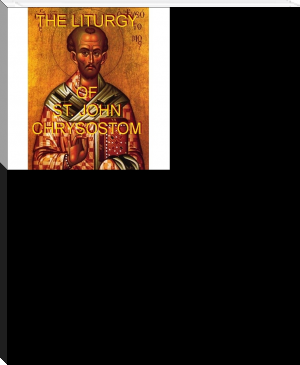
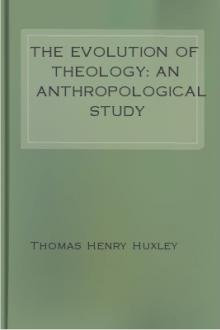
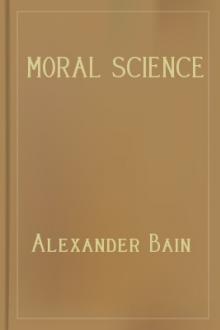
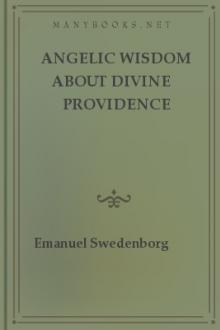

Comments (0)